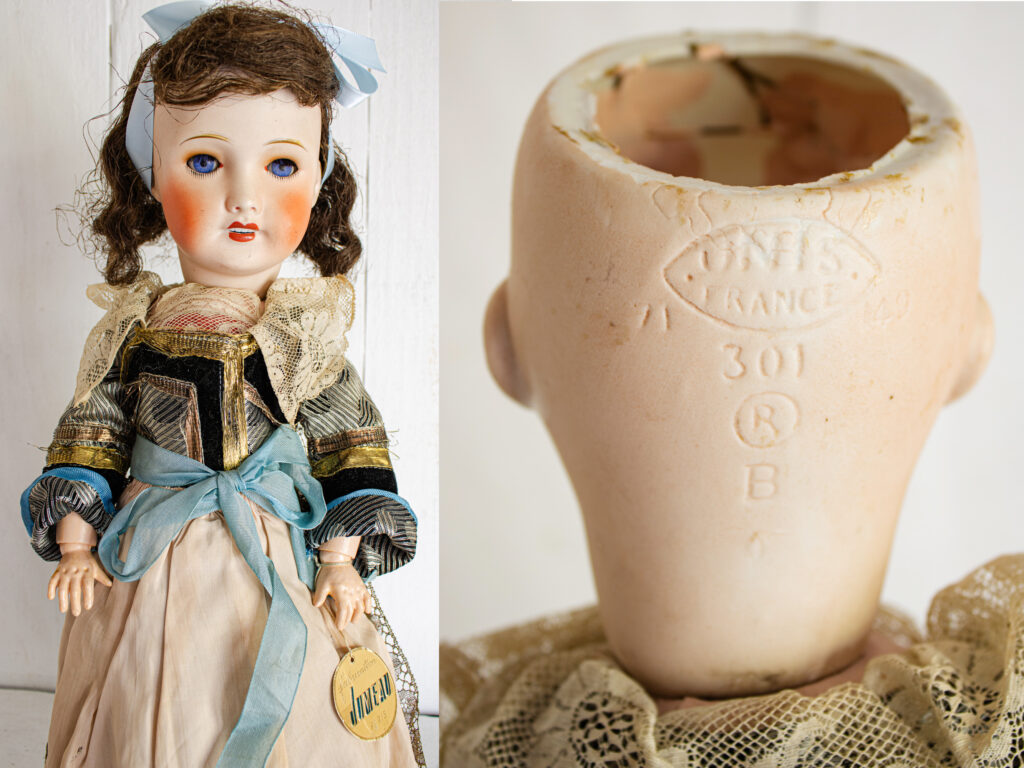A Unis France 301 doll bears a mark used by S. F. B. J. doll maker. SFBJ stood for Société Française de Fabrication de Bébés et Jouets. (The French Society for the Manufacturing of Dolls and Toys)
Background
The phrase “UNIS-FRANCE” was a collective trade mark not a company trademark. In fact the numbers beside the word indicate the specific company SFBJ. The UNIS FRANCE mark was found on many items from dolls to slide rules, and even punched card machines. It guaranteed the product had a French origin.
Conversations began in the 1890s around creating treaties to protect against counterfeits. France joined a group of eight countries that signed such a treaty in Madrid in 1891 (a treaty favorably received by French wine producers.)
Ireland created the first collective trademark in 1906 by the Irish Industrial Development Association.
The discussions over trademarks bearing the origins of the product did not go well in the minds of all manufacturers. Some argued that they didn’t want the origins known. For example, let’s say a distributor in England sells a large number of products in bulk to a buyer from a foreign country. The English distributor obtained the dolls from German factories. When the foreign buyer sees the words “made in Germany” on the product, they decide they don’t need to buy from the English distributor but to go directly to Germany for the lower prices. Then the English seller loses the opportunity to resell the dolls for profit.
Yet with the tensions of WWI and the abundance of German products in the market, especially in the American market, authenticating products for the sake of imports, exports, tariffs, and all that relates, laws were written that required marks of origins.
The English, one day, obsessed, as we have been, with the abundant and superabundant introduction, at their pleasure, of German goods, caused a bill to be passed prescribing that all the products of Germany which should enter England should bear the Mark : Made in Germany. A few months later, all imported German products carried this designation.
—Architecture. Bulletin published by the Central Society of Architects during the wartime, Academie d’architecture, June 1, 1916; Librairie Ch. Massin
As the French discussed what mark to use to comply with British laws for imports, the French did not want to follow the Germans by putting “made in…” on their products. They wanted something unique.
UNIS: Union Nationale Inter-Syndicale des marques collectives
In 1915, under the presidency of Mr. David-Mennet, the Chamber of Commerce of Paris founded the the Union Nationale Inter-Syndicale of collective marks (UNIS). Its collective mark is made up of the succession of the first letters of its name. By 1916, 52 unions had joined. They claimed the purpose to create and protect authentic French products. Some called the idea remarkable, others argued it would not work. Remember, the idea came about in the midst of world war 1 when tensions already existed in European markets.
Requirements to Use the Unis France Mark
Among the rules agreed upon, the UNIS-FRANCE words were not allowed on products of poor quality. The mark first had the words inside a circle and then over time it developed more into the shape of an oval. Also, the manufacturer had to be French producing products in France. Exceptions occurred for foreign parts that France could not produce with the same high quality or price. The union even required French origins of the raw materials where available. The strictness of the requirements caused the many manufacturers not to use the mark.
An advertisement (below) from the 1928 issue of the French annual almanac of commerce demonstrates SFBJ using the UNIS FRANCE doll mark at the very bottom of the ad. (See some other antique French doll markings here.)
The 71 and 149 Numbers on the UNIS FRANCE 301 Doll Head
The Union set up a numbering system to identify the manufacturer of the product. As you see on this Unis France 301 Doll has the number 71 on the left of the mark. The number on the left represented the trade syndicate or union of which S.F.B.J. was part. On the right you see the number 149 which represents the company S.F.B.J.

Further Reading
- Read about other SFBJ 301 dolls here.
- Learn more about identifying antique dolls here.
- See some other French Doll Marks here.
- See some French doll shoe markings here.
- If you would like to see other French doll trademarks, click here.
